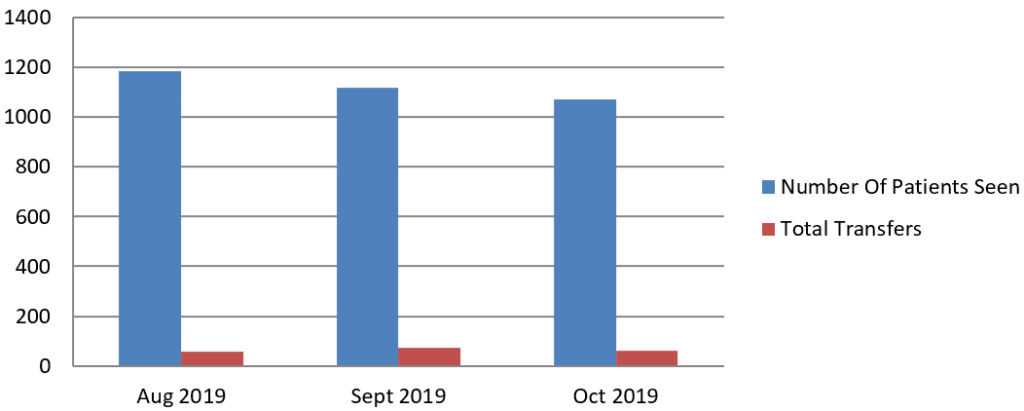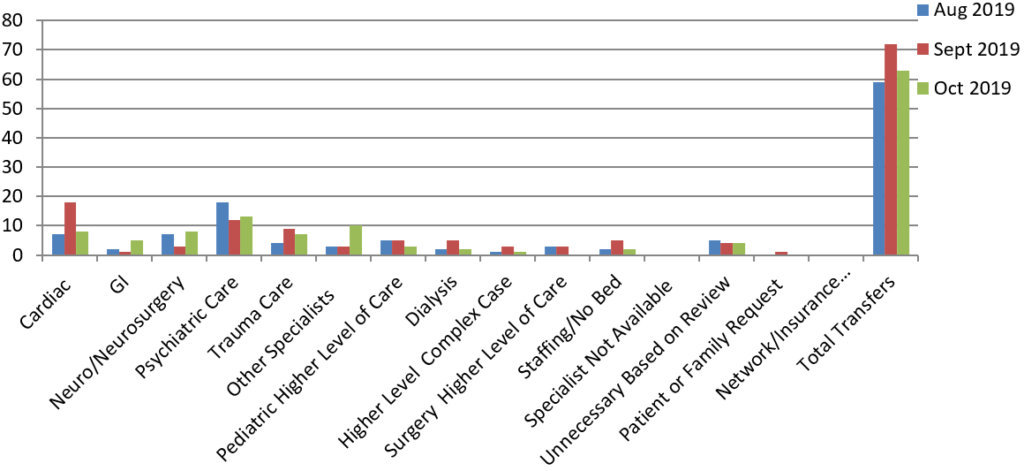Quality and Patient Satisfaction
4-Star CMS Rating
Holy Cross Hospital is proud to announce that we have been awarded a 4-star CMS rating. The CMS rating compares hospital’s across the country and our 4-star rating ranks holy cross among the best hospitals in New Mexico. We have been proud to serve our community since 1936 and our 4-Star rating is proof of the great quality care you can receive right here in Taos. For more information on CMS ratings, visit: https://www.medicare.gov/hospitalcompare/About/Hospital-overall-ratings.html
Very Low Infection Rates
Did you know that Holy Cross Medical Centers (HCMC) rates of infection are lower than most other hospitals? The National Health and Safety Network standard infection ratio is used to track rates of infection in healthcare facilities at the national, state and local level over time. HCMC standard infection ratio is set at < 1. A ratio of < 1 means the hospital is having fewer infections than predicted. Annually our results are well below the goal showing we are providing safe care to those we serve.
| Hospital Acquired Conditions | Goal/NHSN | 2019 YTD | Q3 19 | Q2 19 | Q1 19 | Q4 18 |
|---|---|---|---|---|---|---|
| Surgical Site Infections Colon (NHSN) | < 1.0 | 0.00 | 0.00 | 0.00 | 0.00 | 0.00 |
| Surgical Site Infections Hysterectomy (NHSN) | < 1.0 | 0.00 | 0.00 | 0.00 | 0.00 | 0.00 |
| Catheter Associated Urinary Tract Infections (NHSN) | < 1.0 | 0.00 | 0.00 | 0.00 | 0.00 | 0.00 |
| Central Line Associated Bloodstream Infections (NHSN) | < 1.0 | 0.05 | 0.00 | 0.00 | 1.49 | 0.00 |
| Methicillin Resistant Staph. aureus Infections (NHSN) | < 1.0 | 0.00 | 0.00 | 0.00 | 0.00 | 0.00 |
| Clostridium difficle Infections (NHSN) | < 1.0 | 0.00 | 0.00 | 0.00 | 0.00 | 1.69 |
Patient Transfers
Did you know that HCMC tracks the number of patients transferred to other healthcare facilities from our emergency department(ED) each month? We do this to make sure we are not transferring anyone unnecessarily. We only transfer patients when our medical staff determines we cannot provide the level of care needed. Our mission is to provide our community with high quality health care choices close to home. We live out our mission by providing emergent care to all individuals who visit our ED. More than 90% of our ED patients are kept here at home.
ED Patients Seen and Transferred

Reasons Patients are Transferred From the ED

Patient Satisfaction
Did you know your satisfaction is a priority to HCMC? Monthly surveys are mailed, emailed or texted to patients who have been in the Hospital, in the Emergency Room, had Surgery or been served in one of our Ancillary Departments: Lab, Imaging, Physical Therapy, Physical Therapy, Anticoagulation, Diabetes, Infusion and Wound Care. We want to know how we are doing so we can learn and improve. This quarter we want to highlight two of our services that are ranked in the 99th %tile for Customer Satisfaction compared to 130 other Critical Access Hospitals, Rehabilitation/Physical Therapy Service and Anticoagulation Clinic.
Overall Mean Scores – Outpatient Services: Rehab Services

Overall Mean Scores – Outpatient Services: Anticoagulation

DNV accredited and ISO 9001:2008 certified
Holy Cross Hospital is DNV accredited and ISO 9001:2008 certified. We were the first health care provider in New Mexico to have achieved this certification of excellence. To remain accredited and ISO certified we have to go through an annual external peer assessment process with DNV. They will accurately assess our level of performance in relation to established standards and we in turn will implement process improvement measures based on the assessment.
The annual survey team consists of a clinical surveyor, generalist surveyor and physical environment/life safety surveyor. All DNV surveyors are also ISO lead auditors. The survey team will identify deficiencies and corrective action plans will be established to address the findings. All clinical, patient care areas, non-clinical and off-campus support areas are surveyed including an emphasizes on the role of the Leadership Team. DNV requires that hospital management provide resources to support changes and fixes to nonconformities identified in the hospital. There is also an extensive review of our Quality, Risk, Safety, and Infection Prevention, programs. Other DNV requirements include: facility management systems, a managed barrier penetration permit program, security management, occupational safety and health administration requirements, emergency management, medical equipment management system, and a workplace violence program.
PATIENT SAFETY
Your safety is our top priority. We are committed to ensuring you receive the safest care possible and have put in place numerous measures to ensure your protection. We invite you and your family to be active participants in your care and a partner with your caregivers.
We work to provide the safest health care environment, so our patients can benefit from:
- Reduced infection rates
- Reduced chance of hospital-acquired injuries and medical mistakes
- Reduced hospital stays and costs
- Improved health outcomes
We are constantly evaluating and implementing ways to improve patient safety. Please speak up when you have questions or concerns.
Ways we keep our patients safe:
- Accurate patient identification – We will always ask you at least two identifiers: Name (first and last) & Date of birth
- Electronic Health Record
- Safe medication practices
Quality describes the entire patient experience in our facilities, from the way a receptionist greets you upon check-in, to the final outcome of your procedure. Holy Cross Medical Center’s staff and physicians at all levels are working each day to make patients safer. From little things, like double- and triple-checking ID bracelets, to big things like standardizing surgical procedures, a lot goes on behind the scenes to improve quality of care.
LIFE WINGS
Holy Cross Hospital initiated a Lifewings patient safety initiative in 2006.

Lifewings is a nationally-known aviation based safety program and is recognized in the health care field for bringing similar techniques to patient safety programs. Their program has resulted in long term improvements in patient safety, reduced medical errors, increased efficiencies, reduced costs and less hospital staff turnover for many organizations across the nation.
Some of the Lifewings tools put into place include:
- Pre-procedure checklists
- Time-out before surgery
- Changes in reporting mechanisms
- Readmission reduction program
- Falls prevention team
This means our continued top priority will be delivering the highest level of medical care to each and every one of our patients. The Lifewings program provides better communication and effective team building between physicians, nurses, technicians and all hospital staff.
Holy Cross Medical Center’s commitment to always improve the quality of our care gives our patients better customer service, a safer health care environment and better patient outcomes.
Quality improvement can lead to:
- Improved patient satisfaction
- Decreased incidence of infections
- Reduced medical mistakes
- Shorter hospital stays
- Improved health outcomes
Our patients’ satisfaction is integral to health care quality.
We are committed to improving patient satisfaction at Holy Cross Medical Center. We constantly seek feedback from our patients and their families in order to improve the overall patient experience.
Patient surveys are sent to every hospital inpatient, and sent to randomly-selected hospital outpatients.
These results, when combined with Core Measure results, provide a picture of the “quality” of our hospital.
Hospital Consumer Assessment of Healthcare Providers and Systems (HCAHPS) / Customer satisfaction survey
The Centers for Medicare & Medicaid Services (CMS) created the HCAHPS initiative to provide a standardized survey instrument and data collection methodology for measuring patients’ perspectives on hospital care.
- It is the first national, standardized, publicly reported survey of patient’s perspective of hospital care and patient experience
- Required of all hospitals that receive Center for Medicare & Medicaid funding. The exceptions are Cancer Centers, Pediatric Hospitals and VA’s
- Give patients a reliable source of data that provides insights into the quality of healthcare
- Standardized, assures all patients in all hospitals across the United States are asked the same questions in the same manner
At Holy Cross Hospital, we work hard to provide the kind of care you’d get from friends and family in the comfort of your own home. We partner with Press Ganey, a company that conducts patient satisfaction surveys. By completing the Press Ganey survey, sharing your feedback on how we’re doing and offering suggestions for improvement, you help us be the best provider we can be.
This survey asks questions in nine different sections, such as:
- Communication with nurses
- Communication with physicans
- Responsiveness of hospital staff
- Communication about medicines
- Discharge information
- Cleanliness of the hospital environment
- Quietness of the hospital environment
- Transition of care
- Pain management
The purpose of administering this survey has three goals:
- Ability to produce data that is used to compare hospitals
- Incentives for hospital to improve quality of care, by publically reporting the survey results.
- Enhance public accountability by increasing the transparency of hospital care with releasing of public survey results.
Your feedback is very important to us. It helps us monitor how we are doing, and the federal government monitors us as well. Our patient surveys are charted nationally and compared with other hospitals nationally to give an idea of how we compare. By sharing your thoughts, you can help us make our care better in the future – and we have the opportunity to recognize staff who may have gone above and beyond during your care.
CORE MEASURES
What are Core Measures?
Core measures were established by CMS in 2000. They began publicly reporting hospital data relating to core measures in 2003.
We measure the quality of our care through core measures. To do this we monitor the use of recommended treatments that scientific evidence shows produce the best results. They have been shown to result in improved clinical outcomes for patients. Healthcare experts and researchers have found that these treatments reduce the risk of complications and prevent recurrences.
How Do Core Measures Help?
These measures provide a national, evidence-based standard of care. Much time and effort has gone into researching and studying patient care, to determine which practices produce the best outcomes for patients. At Holy Cross Hospital, physicians and hospital staff have collaborated in developing core measure policies, guidelines, and protocols; using the CMS measures as a guide, we can determine where we are already succeeding, and where we must focus our efforts to continue providing the best possible care to our patients.
A few of the areas we measure:
- AMI-Acute Myocardial Infarction (Heart Attack)
- ED Throughput Measure
- VTE-Hospital Acquired Potentially Preventable Venous Thromboembolism
- OP23- Head CT Results for Stroke Patients Received Within 45 Minutes of ED Arrival
- OP5-Median Time to ECG
LINKS
Quality indicators are reported by a number of independent organizations. These Web sites may be useful in gaining a better understanding of the quality reporting process and in comparing the quality of Holy Cross Hospital with other hospitals and health care organizations.
Links provided to these organizations are not endorsements of these sites or the information they provide.
DNV
DNV is a program to help healthcare providers effectively manage risk and improve healthcare delivery. The focus is to develop systems that help achieve significant, measurable improvements that have a rapid and positive outcome. Being an accredited organization under DNV is a commitment to improving patient quality and safety through a sustainable quality and risk plan.
DNV’s pioneering NIAHO program integrates ISO 9001 with the Medicare Conditions of Participation. They received CMS Deeming Authority in 2008, and since then have accredited nearly 500 hospitals of all sizes and in every region of the United States.
How is this accomplished?
By offering education on compliance and standards in infection prevention, being an advisor and suggesting ways to make improvements in the healthcare organization. DNV combines with the ISO 9001:2008 standards in which the main goal is quality over quantity, and building a healthcare system that is always moving forward.
The significance of DNV is that it provides a plan that identifies goals and find where improvement is needed throughout the organization. The commitment to improving quality, safety and patient experiences is what DNV accredits institutions who are willing to progressively move forward with these commitments.
International Organization for Standardization (ISO)

Holy Cross Medical Center is ISO 9001:2008 certified which means they have accomplished the international standardized criteria for:
- promoting global harmonization of medical practices – insuring that medical care is the same high quality across certified facilities,
- protecting the health and safety of patients and healthcare providers,
- supporting efficient exchange of information and protection of data, and
- continuously improving the quality of care provided.
The significance is that it helps ensure the patients are getting consistent, good quality products and services. The quality principles encompass a strong customer focus, the motivation and implication of top management, the process and the continuous improvement.
Centers for Medicare and Medicaid Services

The Centers for Medicare and Medicaid Services (CMS) provides hospital quality data on its www.hospitalcompare.hhs.gov web site. The link allows you to compare Holy Cross Hospital patient satisfaction scores to other regional and national hospitals. The rating tool includes information on how well the hospitals in given areas care for their adult patients with certain medical conditions.
Hospital Compare was created through the efforts of the CMS and organizations that represent hospitals, doctors, employers, accrediting organizations, other federal agencies and the public.

